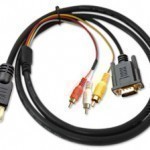A VGA adapter is a component that has a male side and a female side that allows for graphics to be presented on a screen. VGA which stands for video graphics array is a method in which information is presented on a screen. Currently, it is the "lowest common denominator" when it comes to the type of graphics that a computer will have. The base is VGA and then any components added supercede the VGA. History of VGA In 1987, IBM unveiled the display hardware known as VGA. It was Read More
How Does TiVo Work?
A common word that is constantly uttered in our society, TiVo has revolutionized the way we watch TV. With its many features and functions that allow you to pause, record, and rewatch television, TiVo has quickly ushered in an age in which we no longer watch commercials and we don't worry about being home at 8 o' clock to watch our favorite sitcom. Many people, however, still do not know the wonders of TiVo and many more do not understand how it works. In this article, we will explain what Read More
How to Program a Sanyo Universal Remote
Programming a universal remote–be it a Sanyo or any other–requires that you have the codes that correlate the remote to all the other hardware in the room. For example, if you are going to be using the universal remote to handle the DVD player and the TV, it is important to have the codes for both those pieces of hardware that correlate specifically to the Sanyo Universal Remote. The first step in programming the remote is to get those codes. To do it, find the model number and manufacturer's number Read More
Widescreen
Widescreen usually refers to the aspect ratio of an image. In general terms, most images are considered to be in widescreen format when they have an aspect ratio larger than 4:3. When talking about widescreen, generally, most people are referring to the aspect ratio or shape of their TV set, monitor or digital image. One of the best ways to understand widescreen is to compare it with the most common type of aspect ration, 4:3 which is the aspect ratio or shape of a standard TV set. A standard TV Read More
Entertainment System
Most people characterize an entertainment system as both audio and video components that can play a variety of media. While many people might think of a home theater system as an entertainment system, you don't necessarily need all home theater components to produce quality entertainment. Audio Entertainment System An entertainment system might be defined by some as components that can reproduce audio media such as a receiver, CD player and speakers. You can purchase these audio components separately or purchase them as an integrated audio system. Many boom boxes or Read More
Digital Audio-Video Cables

For audio and video lovers the good news is that there are many types of digital audio and video (A/V) cables to choose from. Usually these cables are made from either copper wire that is shielded and housed in strong casing or fiber optic usually made from clear plastic which uses pulses of light to send data. Types of Digital A/V Cables Two types of digital cables are either coaxial or optical in material. Here is some basic information. Coaxial Cables Coaxial cables use a copper center that is shielded Read More
NTSC (National Television Systems Committee)
NTSC (National Television Systems Committee) is the standard for analog television transmission in the United States and many other counties worldwide. NTSC was developed in 1953 by the National Television System Committee. Alternatives to NTSC were developed later, including PAL and SECAM. NTSC provides 482 lines of vertical resolution and 16 million colors. NTSC transmits 525 lines, but some lines are used for sync, vertical retrace, and closed captioning. NTSC delivers 29.97 frames per second. NTSC does this by delivering 59.94 interlaced half-frames per second. Interlacing is a technique of Read More
Picture Quality
Picture quality is a general term used by the viewer to rate the inherent quality of the image. It is mainly subjective, meaning that each viewer rates the picture quality differently. Some people may think that an image is high enough quality, but you may have an individual with higher standards that may say the image lacks quality or sharpness. Picture quality is used in a general sense. With digital images, many people are able to rate and categorize images based on bits of information or pixels that create an Read More
How to Convert HDMI to RCA

Nowadays, most consumer electronic devices support the HDMI (High Definition Multimedia Interface) output for video and image downloads. Before HDMI became popular in the electronic industry, RCA connectors (yellow, white, and red cables) were primarily used to connect DVD players, video game consoles, and set top boxes to televisions or monitors. A common issue for consumers is converting their HDMI devices to RCA cable inputs in order for them to play on older television sets or monitors. How to Convert HDMI to RCA Step 1 – Search for an HDMI Read More
Refresh Rate
The Refresh rate is the number of times a display's image is repainted or refreshed per second. As it denotes a frequency of a process, the refresh rate is expressed in hertz. That is, a refresh rate of 75 Hz means the image is refreshed 75 times in one second. For academic interest, it should be kept in mind that refresh rate is different from frame rate in that refresh rate means the repeated illumination of identical frames, while frame rate measures how often a display image can change into Read More


Share on: